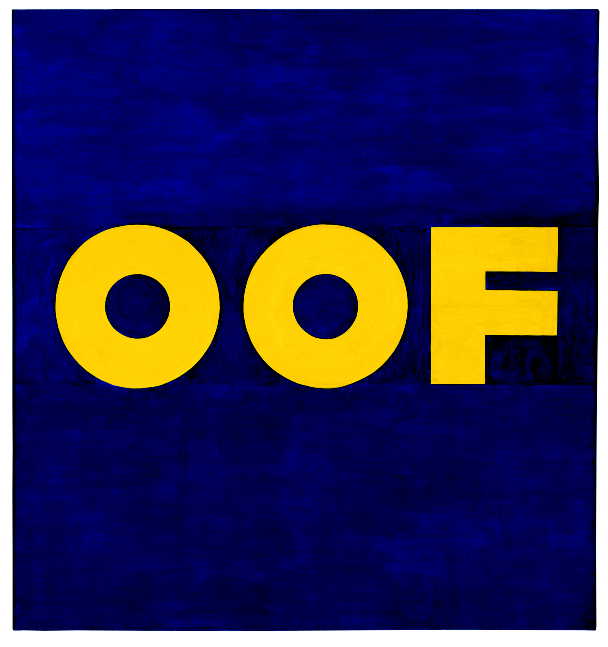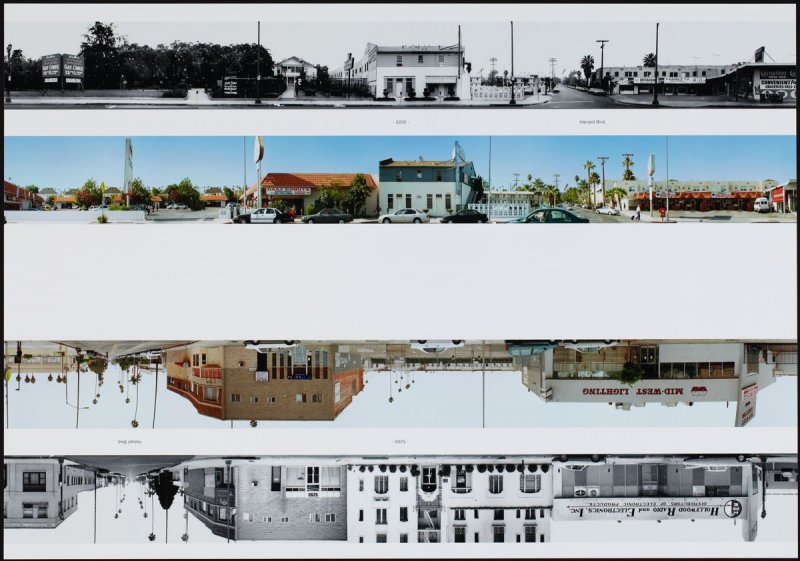
In contrast to the now near ubiquitous ‘photobook’ in contemporary photographic practice, as Di Piero (2012: 49) observes, ‘for Ruscha, a book can be an icon, an archive, a technology, an action zone, an artistic support, a motif.’ This suggests that, in engaging with Ruscha’s work in book form, we should take care to consider how each work is situated in relation to these possibilities. This is particularly important in considering the selection, cropping and placement of images, the form taken by the book (for instance, how it is bound and the use of blank pages), the form and use of text (including fonts used and the layout of the cover, title and other pages) and titles (including the variations in precision in relation to quantity, from ‘twentysix’ to ‘various’, for instance) and the pacing and rhythm of the images. Given Ruscha’s particular interest in words as a component, or, indeed, the primary focus, of his visual work, the book provides an apposite medium for his art, making it far more than a ‘portable exhibition’ (Lippard, 1977). As Dziewior (2012) observes, there is a subjective rhythm to Ruscha’s books, in, for instance, the shape and arrangement of images, which contrasts with the formality of the covers. The shape, pattern and arrangement of words is purposeful, as it is in Ruscha’s work more generally, and paper is carefully chosen. Narrative structure is asserted in some works (Twentysix Gasoline Stations gives a sense of a three day journey in its arrangement of images, with the Fina image marking an end point) and subverted in others (for instance, in the lack of discernible structure in, say, the arrangement of images in Real Estate Opportunities). And there are jokes (‘Camera facing west on all photos’ in A Few Palm Trees), fitting of the creator of OOF.

As an artist, Ruscha is very much embedded in place, specifically Los Angeles, and more precisely Hollywood, (see Schwartz, 2010). Given the focus of my work on urban regeneration, it is this place related aspect of Ruscha’s work that most interests me. Reynolds (2015) explores Ruscha’s relationship with the redevelopment of Hollywood through the analysis of Then & Now: Hollywood Boulevard, 1973-2004, which consists of two continuous panoramas of the north and south sides of Hollywood Boulevard at two different points in time, thus mapping the transformation of the neighbourhood resulting from the Hollywood Redevelopment Project (HRP). The format of the book revisits the structure of his earlier Every Building on the Sunset Strip. Reynolds’ reading challenges the view that Ruscha’s art is primarily nostalgic, and draws out the potential of the juxtaposition of images in this way for a more radical reading, which subverts the idea of the reclaiming of a golden age, framed in this case by the fantasies of the Hollywood film industry. Space is left in the work for a more dynamic relationship between the past and the present and for imagining possible, non-utopian, futures.

Then & Now: Hollywood Boulevard, 1973-2004 is the only work by Ruscha using this form of juxtaposition, accentuating change over time. His other Los Angeles works focus of a given point in time, and present images of the vernacular architecture of the city. The drabness of the images makes it difficult to view this work as nostalgic. In engaging with this work for this task, I want to get a firmer sense of the how the books that focus specifically on Los Angeles might constitute a form of critique of development, and how the process of construction of similar texts might provide a means of exploration of both personal relation to place and the dynamics of change in the built environment.
Ideally, I would have focused on exploration of East London in the creation of some Ruscha style books. However, the task was set just a few days before setting off to work in Australia, so I have focused on issues relating to that move, and to my Australian context. I have produced three books: Illegal Immigrants, Twelve Barber Shops, and High Pedestrian Traffic. There are separate posts about each of these below. If I can make the time, I might put together a book focusing on east London, using street level images from Google Maps.
The camera may not quite have ‘always been facing west’, but I have been a little frivolous with this activity, partly as a result of the demands of my current work in Australia. Given more time, I’d explore the relationship between the images more carefully – the Hunter Street works have an explicit material basis for sequencing (they both follow the numerical order of the buildings) which pragmatically (given time constraints) denies the opportunity to construct a visual pattern or rhythm. I would also like to explore the relationship between text and image further, and examine the relationship between the organisation of text in Ruscha’s books to his other text based art (he discusses his attraction to the treatment of text as blocks in this interview), and, in my own work, pursue the case for thinking more about the function of text in cityscapes (Text in the City?). In relation to the production of books, exploring Ruscha’s work has increased my interest in non-narrative oriented books (where sequences do not ‘tell a story’, and might even subvert narrative form).
I have an appointment to visit the Study Room at the Art Gallery of New South Wales on Friday to look at their holding of Ed Ruscha photobooks, so will write more when I’ve had the opportunity to actually see and handle some of the work.
References
Di Piero, W.S. 2012. ‘The sand is in the vaseline’. In Reading Ed Ruscha, edited by Y. Dziewior and K. Bregenz. Köln: Kunsthaus Bregenz. 46-53.
Dziewior, Y. 2012. ‘Reading Ed Ruscha’. In Reading Ed Ruscha, edited by Y. Dziewior and K. Bregenz. Köln: Kunsthaus Bregenz. 18-25.
Lippard, L. 1977. ‘The artist’s book goes public’. Art in America, Jan-Feb 1977; reproduced in Lippard, L. 1984. Get the Message? A Decade of Art for Social Change. New York: E.P. Dutton. 48-52.
Reynolds, M. 2015. ‘Landscape in Motion: Nostalgia and Urban Redevelopment in Ed Ruscha’s Then & Now: Hollywood Boulevard, 1973-2004’. Journal of Urban History, 41(6): 1052–1072.
Ruscha, E. 2013. The Tension of Words and Images. TateShots. Video interview available at: https://www.youtube.com/watch?v=HoNePbo9DD0 [accessed 20.05.19]
Schwartz, A. 2010. Ed Ruscha’s Los Angeles. Cambridge, Mass.: MIT Press.
